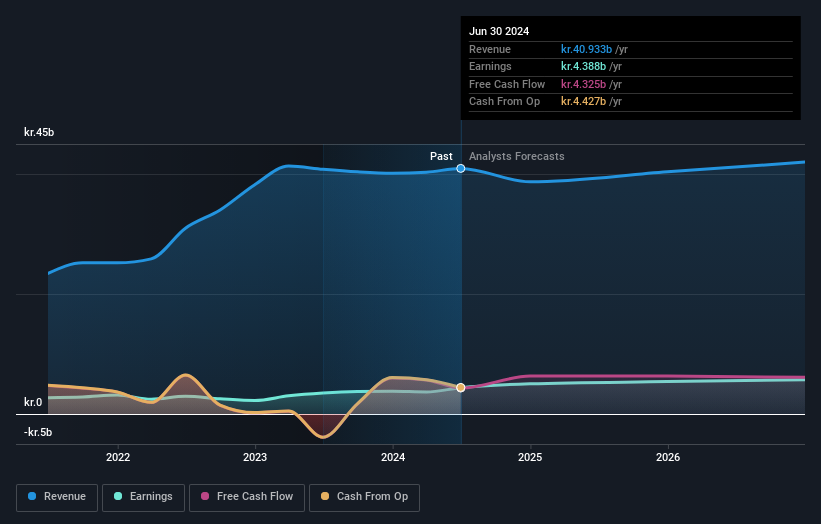While individual investors own 27% of Tryg A/S (CPH:TRYG), private companies are its largest shareholders with 49% ownership

Key Insights
- The considerable ownership by private companies in Tryg indicates that they collectively have a greater say in management and business strategy
- A total of 2 investors have a majority stake in the company with 52% ownership
- Institutions own 24% of Tryg
If you want to know who really controls Tryg A/S (CPH:TRYG), then you'll have to look at the makeup of its share registry. We can see that private companies own the lion's share in the company with 49% ownership. Put another way, the group faces the maximum upside potential (or downside risk).
Meanwhile, individual investors make up 27% of the company’s shareholders.
In the chart below, we zoom in on the different ownership groups of Tryg.
View our latest analysis for Tryg

What Does The Institutional Ownership Tell Us About Tryg?
Many institutions measure their performance against an index that approximates the local market. So they usually pay more attention to companies that are included in major indices.
Tryg already has institutions on the share registry. Indeed, they own a respectable stake in the company. This implies the analysts working for those institutions have looked at the stock and they like it. But just like anyone else, they could be wrong. If multiple institutions change their view on a stock at the same time, you could see the share price drop fast. It's therefore worth looking at Tryg's earnings history below. Of course, the future is what really matters.

We note that hedge funds don't have a meaningful investment in Tryg. The company's largest shareholder is TryghedsGruppen smba, with ownership of 49%. With 3.1% and 2.3% of the shares outstanding respectively, BlackRock, Inc. and Nordea Investment Management, AB are the second and third largest shareholders.
A more detailed study of the shareholder registry showed us that 2 of the top shareholders have a considerable amount of ownership in the company, via their 52% stake.
Researching institutional ownership is a good way to gauge and filter a stock's expected performance. The same can be achieved by studying analyst sentiments. Quite a few analysts cover the stock, so you could look into forecast growth quite easily.
Insider Ownership Of Tryg
The definition of company insiders can be subjective and does vary between jurisdictions. Our data reflects individual insiders, capturing board members at the very least. Management ultimately answers to the board. However, it is not uncommon for managers to be executive board members, especially if they are a founder or the CEO.
I generally consider insider ownership to be a good thing. However, on some occasions it makes it more difficult for other shareholders to hold the board accountable for decisions.
Our data suggests that insiders own under 1% of Tryg A/S in their own names. However, it's possible that insiders might have an indirect interest through a more complex structure. Being so large, we would not expect insiders to own a large proportion of the stock. Collectively, they own kr.120m of stock. It is always good to see at least some insider ownership, but it might be worth checking if those insiders have been selling.
General Public Ownership
With a 27% ownership, the general public, mostly comprising of individual investors, have some degree of sway over Tryg. While this size of ownership may not be enough to sway a policy decision in their favour, they can still make a collective impact on company policies.
Private Company Ownership
We can see that Private Companies own 49%, of the shares on issue. It might be worth looking deeper into this. If related parties, such as insiders, have an interest in one of these private companies, that should be disclosed in the annual report. Private companies may also have a strategic interest in the company.
Next Steps:
It's always worth thinking about the different groups who own shares in a company. But to understand Tryg better, we need to consider many other factors. Take risks for example - Tryg has 1 warning sign we think you should be aware of.
Ultimately the future is most important. You can access this free report on analyst forecasts for the company.
NB: Figures in this article are calculated using data from the last twelve months, which refer to the 12-month period ending on the last date of the month the financial statement is dated. This may not be consistent with full year annual report figures.
Valuation is complex, but we're here to simplify it.
Discover if Tryg might be undervalued or overvalued with our detailed analysis, featuring fair value estimates, potential risks, dividends, insider trades, and its financial condition.
Access Free AnalysisHave feedback on this article? Concerned about the content? Get in touch with us directly. Alternatively, email editorial-team (at) simplywallst.com.
This article by Simply Wall St is general in nature. We provide commentary based on historical data and analyst forecasts only using an unbiased methodology and our articles are not intended to be financial advice. It does not constitute a recommendation to buy or sell any stock, and does not take account of your objectives, or your financial situation. We aim to bring you long-term focused analysis driven by fundamental data. Note that our analysis may not factor in the latest price-sensitive company announcements or qualitative material. Simply Wall St has no position in any stocks mentioned.
About CPSE:TRYG
Tryg
Provides insurance products and services for private and corporate customers, and small and medium-sized businesses in Denmark, Sweden, and Norway.
Solid track record with excellent balance sheet.


